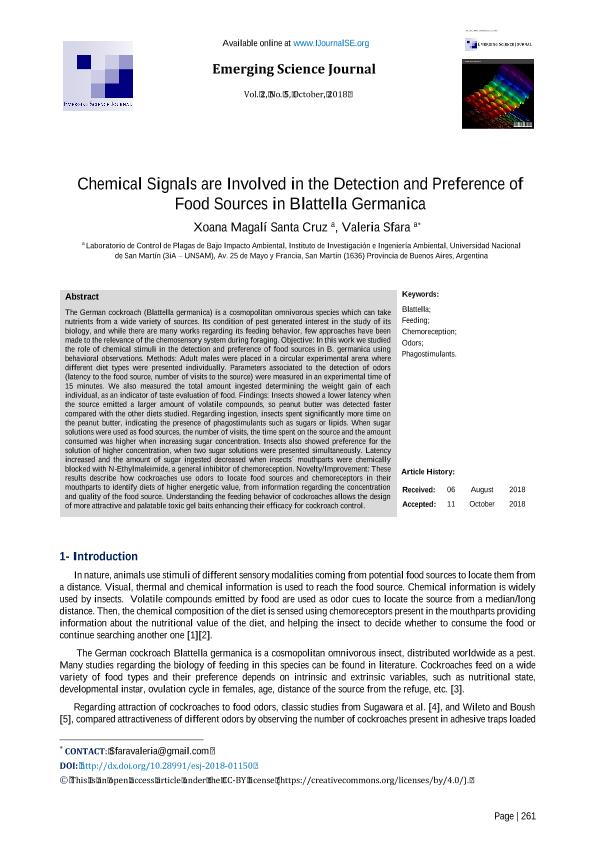Mostrar el registro sencillo del ítem
dc.contributor.author
Santa Cruz, Xoana Magalí
dc.contributor.author
Sfara, Valeria

dc.date.available
2020-02-07T20:47:32Z
dc.date.issued
2018-10
dc.identifier.citation
Santa Cruz, Xoana Magalí; Sfara, Valeria; Chemical Signals are Involved inthe Detection and Preference of Food Sources in Blattella Germanica; Expert Environmental; Emerging Science Journal; 2; 5; 10-2018; 261-271
dc.identifier.issn
2610-9182
dc.identifier.uri
http://hdl.handle.net/11336/96953
dc.description.abstract
The German cockroach (Blattella germanica) is a cosmopolitan omnivorous species which can take nutrients from a wide variety of sources. Its condition of pest generated interest in the study of its biology, and while there are many works regarding its feeding behavior, few approaches have been made to the relevance of the chemosensory system during foraging. Objective: In this work we studied the role of chemical stimuli in the detection and preference of food sources in B. germanica using behavioral observations. Methods: Adult males were placed in a circular experimental arena where different diet types were presented individually. Parameters associated to the detection of odors (latency to the food source, number of visits to the source) were measured in an experimental time of 15 minutes. We also measured the total amount ingested determining the weight gain of each individual, as an indicator of taste evaluation of food. Findings: Insects showed a lower latency when the source emitted a larger amount of volatile compounds, so peanut butter was detected faster compared with the other diets studied. Regarding ingestion, insects spent significantly more time on the peanut butter, indicating the presence of phagostimulants such as sugars or lipids. When sugar solutions were used as food sources, the number of visits, the time spent on the source and the amount consumed was higher when increasing sugar concentration. Insects also showed preference for the solution of higher concentration, when two sugar solutions were presented simultaneously. Latency increased and the amount of sugar ingested decreased when insects´ mouthparts were chemically blocked with N-Ethylmaleimide, a general inhibitor of chemoreception. Novelty/Improvement: These results describe how cockroaches use odors to locate food sources and chemoreceptors in their mouthparts to identify diets of higher energetic value, from information regarding the concentration and quality of the food source. Understanding the feeding behavior of cockroaches allows the design of more attractive and palatable toxic gel baits enhancing their efficacy for cockroach control.
dc.format
application/pdf
dc.language.iso
eng
dc.publisher
Expert Environmental
dc.rights
info:eu-repo/semantics/openAccess
dc.rights.uri
https://creativecommons.org/licenses/by-nc-sa/2.5/ar/
dc.subject
FEEDING
dc.subject
CHEMORECEPTION
dc.subject
ODORS
dc.subject
PHAGOSTIMULANTS
dc.subject.classification
Zoología, Ornitología, Entomología, Etología

dc.subject.classification
Ciencias Biológicas

dc.subject.classification
CIENCIAS NATURALES Y EXACTAS

dc.title
Chemical Signals are Involved inthe Detection and Preference of Food Sources in Blattella Germanica
dc.type
info:eu-repo/semantics/article
dc.type
info:ar-repo/semantics/artículo
dc.type
info:eu-repo/semantics/publishedVersion
dc.date.updated
2020-01-31T19:00:00Z
dc.journal.volume
2
dc.journal.number
5
dc.journal.pagination
261-271
dc.journal.pais
Italia

dc.description.fil
Fil: Santa Cruz, Xoana Magalí. Universidad Nacional de San Martín. Instituto de Investigación en Ingeniería Ambiental; Argentina
dc.description.fil
Fil: Sfara, Valeria. Universidad Nacional de San Martín. Instituto de Investigación en Ingeniería Ambiental; Argentina. Consejo Nacional de Investigaciones Científicas y Técnicas; Argentina
dc.journal.title
Emerging Science Journal
dc.relation.alternativeid
info:eu-repo/semantics/altIdentifier/doi/http://dx.doi.org/10.28991/esj-2018-01150
dc.relation.alternativeid
info:eu-repo/semantics/altIdentifier/url/https://ijournalse.org/index.php/ESJ/article/view/96
Archivos asociados
